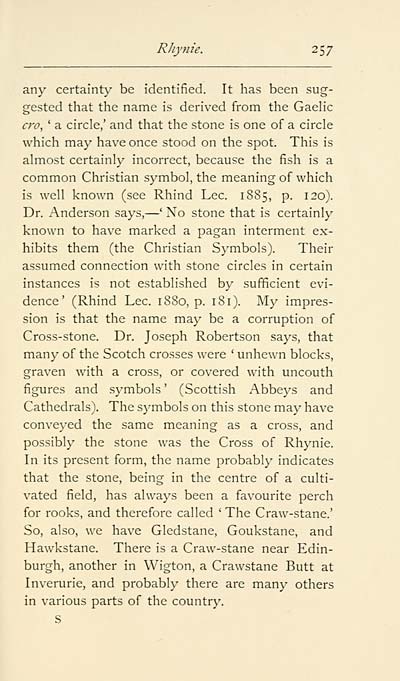Blair Collection > Place names in Strathbogie, with notes historical, antiquarian and descriptive
(281)
Download files
Complete book:
Individual page:
Thumbnail gallery: Grid view | List view

Rhynie. 257
any certainty be identified. It has been sug-
gested that the name is derived from the GaeHc
cro^ ' a circle,' and that the stone is one of a circle
which may have once stood on the spot. This is
almost certainly incorrect, because the fish is a
common Christian symbol, the meaning of which
is well known (see Rhind Lee. 1885, p. 120).
Dr. Anderson says, — ' No stone that is certainly
known to have marked a pagan interment ex-
hibits them (the Christian Symbols). Their
assumed connection with stone circles in certain
instances is not established by sufficient evi-
dence' (Rhind Lee. 1880, p. 181). My impres-
sion is that the name may be a corruption of
Cross-stone. Dr. Joseph Robertson says, that
many of the Scotch crosses were ' unhewn blocks,
graven with a cross, or covered with uncouth
figures and symbols ' (Scottish Abbeys and
Cathedrals). The symbols on this stone may have
conveyed the same meaning as a cross, and
possibly the stone was the Cross of Rhynie.
In its present form, the name probably indicates
that the stone, being in the centre of a culti-
vated field, has always been a favourite perch
for rooks, and therefore called ' The Craw-stane.'
So, also, we have Gledstane, Goukstane, and
Hawkstane. There is a Craw-stane near Edin-
burgh, another in Wigton, a Crawstane Butt at
Inverurie, and probably there are many others
in various parts of the country.
S
any certainty be identified. It has been sug-
gested that the name is derived from the GaeHc
cro^ ' a circle,' and that the stone is one of a circle
which may have once stood on the spot. This is
almost certainly incorrect, because the fish is a
common Christian symbol, the meaning of which
is well known (see Rhind Lee. 1885, p. 120).
Dr. Anderson says, — ' No stone that is certainly
known to have marked a pagan interment ex-
hibits them (the Christian Symbols). Their
assumed connection with stone circles in certain
instances is not established by sufficient evi-
dence' (Rhind Lee. 1880, p. 181). My impres-
sion is that the name may be a corruption of
Cross-stone. Dr. Joseph Robertson says, that
many of the Scotch crosses were ' unhewn blocks,
graven with a cross, or covered with uncouth
figures and symbols ' (Scottish Abbeys and
Cathedrals). The symbols on this stone may have
conveyed the same meaning as a cross, and
possibly the stone was the Cross of Rhynie.
In its present form, the name probably indicates
that the stone, being in the centre of a culti-
vated field, has always been a favourite perch
for rooks, and therefore called ' The Craw-stane.'
So, also, we have Gledstane, Goukstane, and
Hawkstane. There is a Craw-stane near Edin-
burgh, another in Wigton, a Crawstane Butt at
Inverurie, and probably there are many others
in various parts of the country.
S
Set display mode to: Large image | Transcription
Images and transcriptions on this page, including medium image downloads, may be used under the Creative Commons Attribution 4.0 International Licence unless otherwise stated. ![]()
| Early Gaelic Book Collections > Blair Collection > Place names in Strathbogie, with notes historical, antiquarian and descriptive > (281) |
|---|
| Permanent URL | https://digital.nls.uk/81169718 |
|---|
| Description | A selection of books from a collection of more than 500 titles, mostly on religious and literary topics. Also includes some material dealing with other Celtic languages and societies. Collection created towards the end of the 19th century by Lady Evelyn Stewart Murray. |
|---|
| Description | Selected items from five 'Special and Named Printed Collections'. Includes books in Gaelic and other Celtic languages, works about the Gaels, their languages, literature, culture and history. |
|---|

